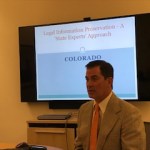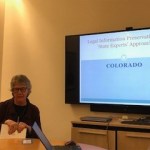LIPA has been busy engaging new audiences with the importance of preservation of legal information. LIPA presented the program, Legal Information Preservation – A “State Experts” Approach at the Best Practices Exchange (BPE) 2017 held in Boston, November 6-8, 2017. In addition to a successful program, LIPA was also a sponsor of the BPE 2017. What is BPE you ask? The BPE is an ‘un’conference of practitioners with a focus on managing, preserving, and providing access to digital information. The Exchange provides an opportunity to discuss real-world experiences, including best practices and lessons learned.
Dan Cordova, Supreme Court Law Librarian, Colorado Supreme Court and Mendora Servin, LIS Coordinator, California Office of Legislative Counsel presented the program. Margie Maes, Executive Director, LIPA served as moderator. Dan, who is also a Member-at-Large on the LIPA Board of Directors, started by explaining why we preserve legal information and provided an introduction to UELMA for those in the audience not familiar with the Act. He described how UELMA is not applied uniformly in adopting states because there is no mandate for uniformity. He directed audience members to consider past print preservation initiatives while thinking about future needs and working towards them. A preservation program should address collaboration, compilation, certification, curation, and consensus. Colorado aims to provide free public access to all Colorado law on one web portal. Dan highlighted some lessons learned: 1) full preservation – compile complete set of current and historical law and if possible, certify print set as official; 2) describe official set with flexible taxonomy using robust metadata; 3) select secure, scalable, and sustainable electronic format for prospective authentication and migrate print to selected electronic format; 4) certify completeness of electronic set; 5) move electronic set to dark archive; and 6) seek needed funding.
In California, Mendora described how they are working to preserve legislative records born digital and are aimimg to secure legislative information for future generations while providing access in cost effective ways. California is an official publisher and works to ensure integrity of the record. She explained that part of preservation is to plan for backup and disaster to ensure continuing usability of the material. The end game is that legislative information is accessible for use by the public on a permanent basis.
Mendora mentioned that a new law, effective January 1, 2018 requires access to certain legislative committee audio/video recordings on the internet in a secure format for a minimum of 20 years. The strategy is to authenticate the recordings at creation. For the audio/video, they are using WORM (write once, read many). WORM is a data storage technology that prevents the drive from erasing or editing data.
She described how their work is cooperative and interdisciplinary involving the legislature, state archives, office of state publishing, legal, IT, and law libraries.
Mendora highlighted what California is doing on the preservation front. First, identify the target legal materials, work with state archives to identify metadata, understand the needs of stakeholders, authenticate legal materials, and establish guidelines for review. Second, identify three archival repositories, automate authentication and preservation, and outline audits and disaster recovery guidelines.
She mentioned that that they are not authenticating materials previously published but authenticating legislative materials going forward.
Mendora talked about keeping XML files. Given changes to legislative materials over time, the XML version contains all cross references to earlier versions. The PDF and XML versions with metadata go into dark archives. They are using Preservica for their dark archives. She described their auditing process of the data which involves quarterly audit of documents and yearly validation of archival data. The dark archive is their gold standard for restoring data.
Mendora wrapped up with her office’s to-do list: authenticate XML, integrate with state archives, implement disaster recovery and business process audits, and implement additional document types.
In the pursuit of preservation, the bottom line and take-away from Dan and Mendora: talk to each other and share ideas to solve issues.






Real-time monitoring is also more secure overall. It allows admins to catch minor breaches before they turn into dolarmonitor.co the stuff of network admin nightmares.